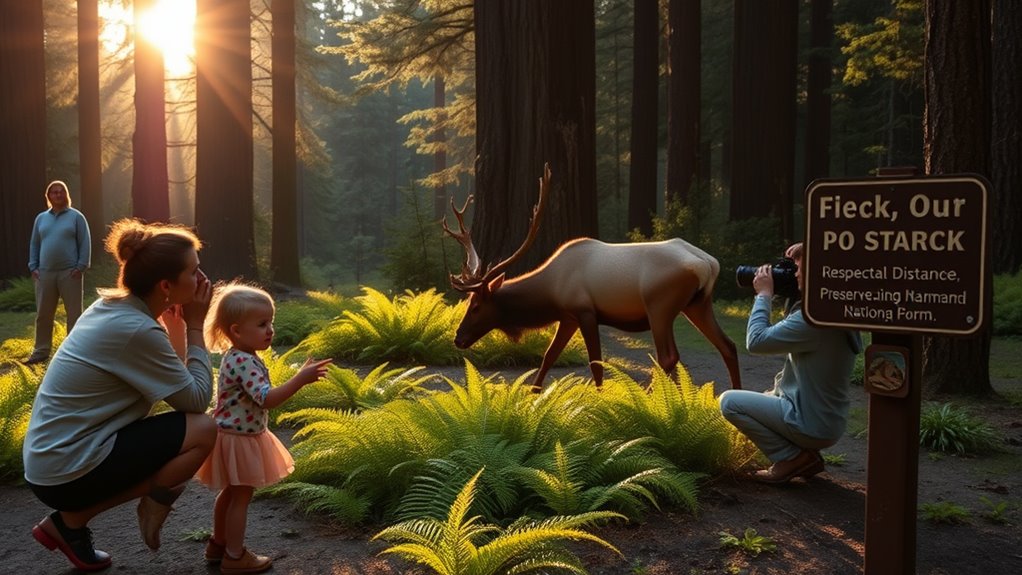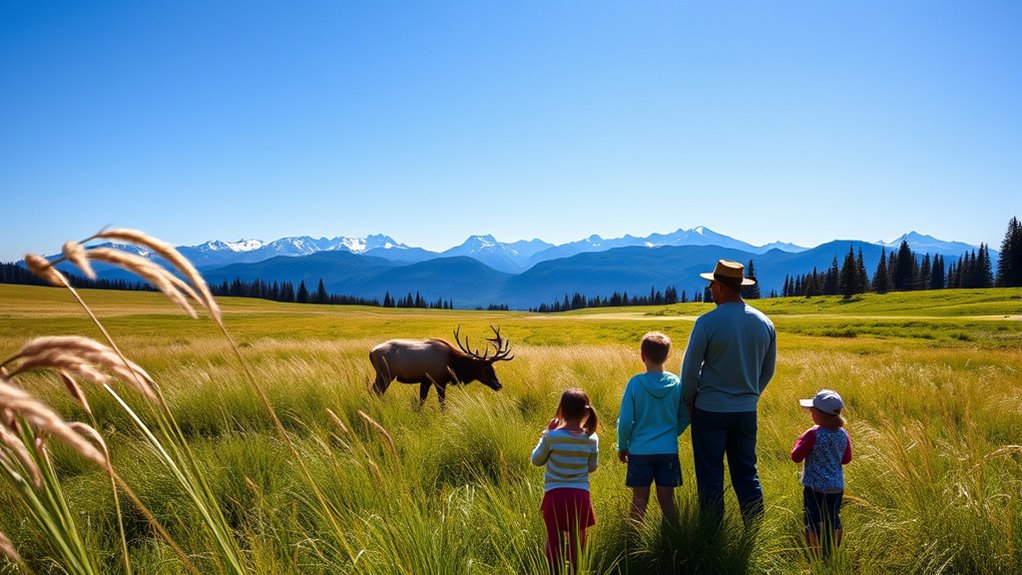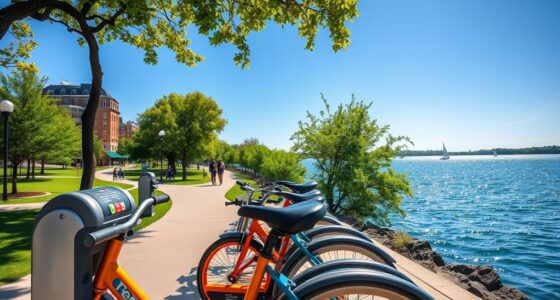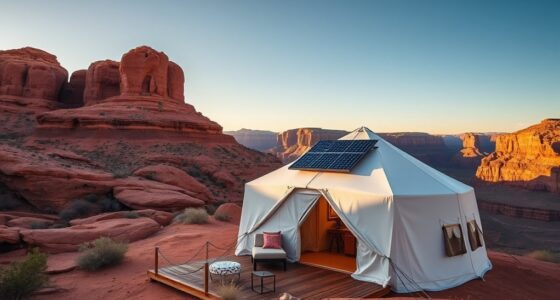When wildlife viewing in Olympic National Park, always keep a respectful distance from animals. Use binoculars instead of approaching them, especially near nesting areas. Maintain silence to avoid disturbing their natural behavior. Try to visit during dawn or dusk when animals are most active. Stick to established trails to protect the habitat and avoid trampling sensitive areas. Practicing these guidelines helps preserve wildlife for future visitors. There’s more to explore about responsible wildlife viewing practices.
Key Takeaways
- Maintain a respectful distance from wildlife to avoid causing stress and disturbance.
- Use binoculars for viewing instead of approaching animals closely.
- Observe wildlife during dawn or dusk when they are most active.
- Stay on established trails to minimize habitat disturbance and protect sensitive areas.
- Follow park guidelines and regulations to ensure a safe experience for both visitors and wildlife.

When you venture into Olympic National Park, remember that respecting wildlife is as essential as enjoying the stunning scenery. The park is home to diverse ecosystems, from lush forests to rugged coastlines, and you’ll likely encounter various animals along your journey. To guarantee a safe and enjoyable experience for both you and the wildlife, it’s important to follow some simple etiquette guidelines.
First off, if you’re passionate about bird watching, you’ll want to be respectful of nesting areas and feeding grounds. Use binoculars instead of getting too close, as many birds are easily startled. When you spot a bird, keep a safe distance, and avoid making loud noises that could disrupt their natural behavior. It’s also wise to research bird watching tips before your visit. Knowing what species are in the area and their typical behaviors can help you appreciate them without intruding on their space.
Respect nesting areas by using binoculars for bird watching, keeping a safe distance, and minimizing noise to protect their natural behavior.
Bear safety is another essential aspect of wildlife viewing in Olympic National Park. Bears inhabit many areas of the park, and while they can be fascinating to observe, you need to prioritize your safety as well as theirs. Always keep a safe distance—ideally 100 yards—and never attempt to approach or feed a bear. If you’re hiking in bear country, make noise to alert them of your presence. Carry bear spray, and know how to use it. If you do encounter a bear, stay calm, back away slowly, and never run.
As you explore the park, remember that wildlife is most active during dawn and dusk. Plan your outings during these times for the best chances to spot animals. However, don’t forget to maintain a respectful distance. If you see other people crowding around a sighting, resist the urge to join the mob. Instead, find a spot where you can observe without adding stress to the animals.
In addition to keeping your distance, consider minimizing your impact on the environment. Stick to established trails and avoid trampling vegetation. Your actions can influence wildlife behavior, and keeping the ecosystem intact is essential for the park’s health. By following these guidelines, you’ll enhance your experience in Olympic National Park and help protect its remarkable wildlife for future generations to enjoy. Always remember, a little respect goes a long way in preserving the beauty of nature. Additionally, understanding grocery savings strategies can help you save money on supplies for your trip, allowing you to focus more on enjoying the park.
Frequently Asked Questions
What Animals Are Most Commonly Seen in Olympic National Park?
In Olympic National Park, you’ll commonly spot various bird species like the bald eagle and the spotted owl soaring overhead. You might also encounter mammal sightings such as black bears, elk, and river otters while exploring the diverse landscapes. Keep your eyes peeled and your camera ready, as these animals often roam freely. Remember, each sighting is a unique experience, so stay patient and enjoy the beauty of nature around you!
Are There Specific Times of Year for Better Wildlife Viewing?
Yes, the ideal viewing seasons for wildlife in Olympic National Park are spring and fall. Did you know that around 200,000 elk migrate seasonally through the park? In spring, you’ll spot newborn animals, while fall brings the dramatic elk rut. During these times, the wildlife is most active, making it suitable for observing different species. Plan your trip around these seasonal migrations, and you’ll enhance your chances of an unforgettable wildlife experience.
Can I Bring My Pet While Wildlife Viewing?
You can’t bring your pet while wildlife viewing, as it poses safety risks to both your pet and the wildlife. Park regulations prohibit pets in many areas to protect natural habitats and guarantee a safe experience for visitors. It is crucial to prioritize pet safety and the well-being of the animals you’re observing. If you’re planning a visit, consider leaving your pet at home or in a pet-friendly area away from the wildlife.
Is There a Fee for Entering Olympic National Park?
Yes, there’s a park entrance fee for Olympic National Park. As of now, it’s typically around $30 for a vehicle. However, if you’re planning to visit multiple times or stay longer, consider getting an annual pass for better value. Also, keep in mind that certain groups, like those with disabilities or veterans, may qualify for a fee waiver, so check for eligibility before your visit. Enjoy your time in the park!
Are There Guided Wildlife Tours Available in the Park?
Yes, there are guided wildlife tours available in the park. Imagine spotting a majestic elk or a playful otter with an expert by your side. Several wildlife tour providers offer guided tour options, ensuring you get the most out of your experience. These knowledgeable guides can share fascinating insights about the park’s unique ecosystem and help you encounter its incredible inhabitants. Don’t miss the chance to connect with nature in a deeper way!
Conclusion
As you stand quietly among the towering trees, a majestic elk grazes nearby, its antlers silhouetted against the golden sunset. Remember, your calm presence is a gift to these creatures; respect their space and observe from a distance. By practicing good wildlife viewing etiquette, you not only protect their habitat but also enhance your own experience. Let the whispers of the wind and the rustle of leaves remind you of the beauty that unfolds when you tread lightly in nature’s embrace.










